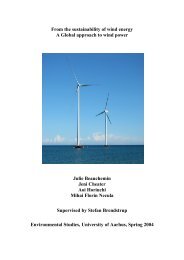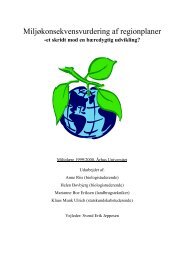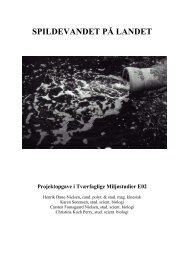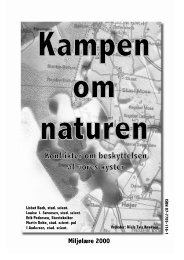University of Aarhus ECOTOURISM AS A WAY TO PROTECT ...
University of Aarhus ECOTOURISM AS A WAY TO PROTECT ...
University of Aarhus ECOTOURISM AS A WAY TO PROTECT ...
Create successful ePaper yourself
Turn your PDF publications into a flip-book with our unique Google optimized e-Paper software.
Ecotourism as a sustainable way to protect nature<br />
hotels do not <strong>of</strong>fer much direct benefit to the local community. The tourists<br />
sleep and eat on the boats, and they are usually discharged for only a few hours<br />
on land to visit the Darwin Research Station and the National park, maybe they<br />
will buy some souvenirs at the station rather than in the town (Honey, 1999).<br />
The less luxury and locally-owned floating hotels are being marginalized<br />
by better-financed companies, who are buying up operating permits, and are<br />
bringing in larger and more luxurious vessels. This has some negative<br />
consequences, as decrease in local employment opportunities, and it contributed<br />
to population growth, because <strong>of</strong> imported staff for larger vessels which demand<br />
more experienced personnel, and a tendency for more pressure on the most<br />
popular visitor sites, because the larger ships want those (MacFarland, 1998).<br />
Since 1980s the Ecuadorians began receiving discounts on flight-tickets,<br />
park entrance and cruise boats. In average foreigners were spending 3.5 times<br />
more than Ecuadorians, yet a much higher proportion <strong>of</strong> the money spent by<br />
Ecuadorians went into the local economy, because they spent their money on<br />
low-quality, local-owned boats and on-land hotels (Honey, 1999).<br />
Tourism has grown gradually and has now reached a total <strong>of</strong> over 60.000<br />
visitors per year and almost 90 vessels. The growth has been driven by<br />
economic interests; it is neither planned technically in relation to natural<br />
resources, nor to market studies. The supply is already exceeding the demand<br />
(MacFarland, 1998). This means that too many accommodations and tourist<br />
activities are being established with no tourists to make use <strong>of</strong> them.<br />
Tourists provide an income for an estimated 80% <strong>of</strong> the people living on<br />
the Galapagos Islands, and 60% <strong>of</strong> all tourism revenues in Ecuador comes from<br />
Galapagos. Only 15% <strong>of</strong> the tourism income enters the islands economy, the rest<br />
goes to the mainland economy. The income from local farmers, cattle ranchers,<br />
47
















